|
Writing / Photography: Su-yi Lin
How long does a seed take to be an old tree?
How long do we need to build the taste of cities?
A historic district is a group of sites, properties, or buildings united historically or aesthetically by plan or physical development. The conservation of historic districts is significant because it reflects developmental patterns for growth in cities. However, it becomes a complex issue when various agents with diverse interests are involved in the process. The development of Qing Tian Community (青田社區) in Taipei City is a good example.
‧ Background
Qing Tian Community, also named Old Tree Community (老樹社區), is located in Da’an District (大安區), one of the most prosperous area in Taipei City. It is famous for the greenery and wooden houses because it was university professors' residential area in the Japanese ruled period. From the 1920s to the 1930s, the Japanese scholars of the Taihoku Imperial University (台北帝國大學), the predecessor of the National Taiwan University (NTU), built their private houses here for the long stay in Taiwan. After World War II, the houses were taken into state ownership and mostly managed by NTU. Some became professors’ dormitories. Some were reconstructed. Nowadays, although many houses have been reconstructed into modern buildings due to the continuously rising urban land price, the Japanese style wooden houses still occupy around one third of the land in Qing Tian Community. Over one hundred old trees are preserved in this area.
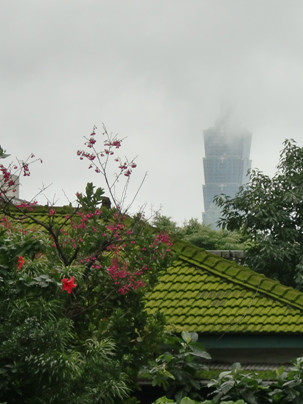
Qing Tian Community shows a mixture of old and new
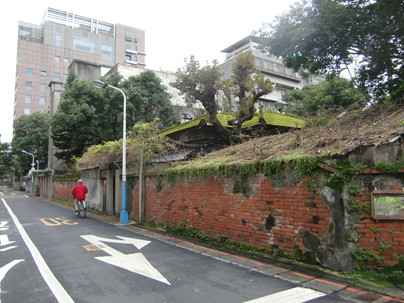
A historic district through time and space
According to the classification of administrative districts, Qing Tian Community equals Long'an Village (龍安里), with 7,459 residents and 3,063 households. It is a residential and cultural area, next to Da’an Forest Park and near NTU, National Taiwan Normal University (NTNU), and National Taipei University of Education. It has a distinction of having the most diverse non-traditional religious architectures in Taipei, including the Holy Family Catholic Church (聖家堂), the Taipei Grand Mosque (清真寺), and the Mongolian & Tibetan Affairs Commission (蒙藏文化中心). The main population is the middle class, particularly the employees in public sectors and schools. Despite the relatively low density of living population in Taipei City, the neighborhood relationship in Qing Tian Community is similar to that in other modern urban residential districts.
The Profile of Qing Tian Community, Taipei City, Taiwan
Area: 0.1848 square kilometers
Population: 7,459 people, 3,063 households
Participators of Community Empowerment and Development: Qing Tian Community Development Association (青田社區發展協會) and Long'an Village Office
Location: No.4-9, Lane 199, Sec. 1, Heping East Rd., Da’an Dist., Taipei City 106, Taiwan
‧Community Development
The development of Qing Tian Community is happening from the bottom up. In November 2002, a few residents initialed a grass-roots club ‘Qing Tian Emerald’ (青田綠寶石) after having a class in the Graduate Institute of Environmental Education, NTNU. They invited their neighbors to understand the community where they have lived, from cultural and historic aspects. In May 2003, the head of Long'an Village Chiu-chia Hung (洪秋甲) and the core members in this club proposed a project ‘The Greenery of Qing Tian Street’ (青田綠映) to produce a community map, a photographic exhibition, and a calendar with the images of Qing Tian Street. Some volunteers interviewed the descendants of the scholars who once lived in the wooden houses. Some volunteers became spontaneous tour guides of this community and distributed local touching stories, such as the documentary film ‘Qing Tian Street, Where I Am Living’ (家住青田街), made by Ms. Yun-hsia Yu (游雲霞).
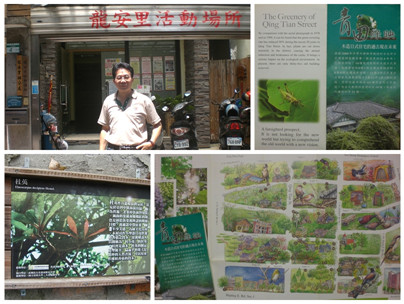
Mr. Chiu-chia Hung and the achievement of ‘The Greenery of Qing Tian Street’
The residents’ sense of community and participation of local affairs have been raised. In July 2003, the household living in No. 9, Lane 7, Qing Tian Street cut an old tree in their garden. It was reported at once for the violation of the Taipei City Tree Protection Bylaw (台北市樹木保護自治條例), which was enacted in April 2003. (Under the bylaw, old trees aged over 50 years and big trees with the girth exceeding 15 meters or the height reaching 15 meters are under protection.). Taipei City Government’s Bureau of Cultural Affairs (台北市文化局) issued its first ticket to the household. Afterwards, the NTU attempted to build scholars’ dormitories in Lane 12, Qing Tian Street. The workers trimmed and cut the trees in the construction site with noisy and dust. The residents realized that the old trees and their living environment could not be well protected when the wooden house owners regarded the trees and the lands as their private assets.
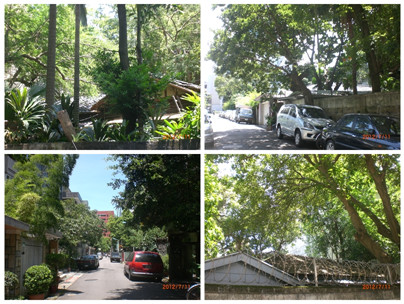
The greenery and wooden houses in Qing Tian Community
To protect the unique natural and historic environment in Qing Tian Community, the residents formed the Community Development Association of Qing Tian and began the Movement of Japanese Style Building Conservation in Qing Tian Street (青田街的日式宿舍保存運動). They expected that the historic district of Qing Tian Street (青田街歷史街區) could be preserved, so they proposed thirty four wooden houses to be the candidates for historic monuments or historic buildings based on Cultural Heritage Preservation Act (文化遺產保存法). On 14 March 2005, the municipal government's Bureau of Cultural Affairs and Department of Urban Development (都市發展局) informed the wooden house owners that they were not allowed to change the houses within two years. However, one owner instantly pulled down his old building at midnight before the effective date of the announcement. In late 2006 and early 2007, four historic monuments and six historic buildings in Qing Tian Community were recognized. The primary objective of the community development association was fulfilled, but the voice of disagreement has become louder.
‧Disagreement
It is hard to simplify the disagreement of Qing Tian Community as the opposition between cultural heritage preservation and economic development. Some complex issues are illustrated as follows. First, the residents think vacant wooden houses could be the blind spots of public security and sanitation. On the other hand, the wooden house owners have financial difficulty to maintain a living house because the only potential compensation on heritage conservation is the Transfer of Development Rights (容積移轉), rather than subsidies for maintenance.
Next, the NTU, which owns nineteen wooden houses in Qing Tian Community, attempts to reuse the houses by a build-operate-transfer (BOT) model. The restaurant in No. 6, Lane 7, Qing Tian Street is the first case. However, when visitors enjoy famous people’s old photos, graffiti, and stories, the neighborhood has to endure noise, cars going the wrong way, and fumes from cooking oils. The head of Long'an Village Chiu-chia Hung stated, “Our residents prefer to have quiet neighbors. The site in No. 5, Lane 6, Qing Tian Street will be a furniture shop. The site in No. 12, Lane 8 will be a gallery. Such cultural shops might be a better choice.”
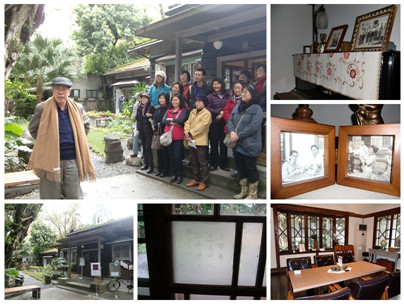
The writer Liang Xuan (亮軒), the son of Professor Ting-ying Ma (馬廷英), is sharing his childhood in No. 6, Lane 7, Qing Tian Street, Taipei
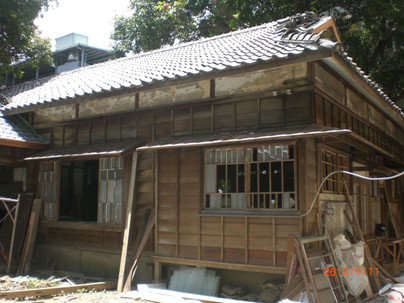
The wooden house in No. 12, Lane 8 is under construction
Third, it is common to see Japanese tour groups on Qing Tian Street, but for local people or Taiwanese visitors, there is not a permanent place to display and pass down the natural, historic, and cultural wealth of Qing Tian Community. The community development association has no fund to do the job. Its chairman Lung-cheng Huang (黃隆正) said, “Some friends suggested us to apply grants from real estate agents, but we denied. We’d like to remain neutral.” When Mr. Chiu-chia Hung endeavored to get the authority of a wooden house in Heping East Road from the Ministry of Transportation and Communications (交通部) to the municipal government's Bureau of Cultural Affairs, the house was locked or rented to teleplay makers.
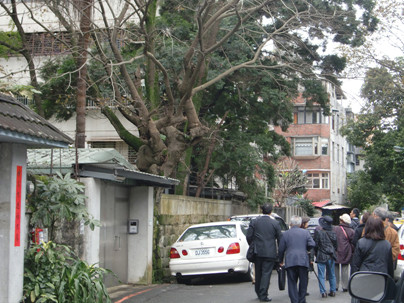
A Japanese tour group is guided on Qing Tian Street
Finally, the whole Qing Tian Community is zoned for historic district conservation according to Taipei City Government’s urban planning. Not only the use of lands but also the height of buildings is under control. Lots of residents consider that the restrictions infringe their benefits from urban renewal (都市更新). As Mr. Chiu-chia Hung said, “Unlike the Qidong Street Japanese Houses (齊東街日式宿舍), our wooden houses are widely distributed over the community. It’s reasonable to control the public assets. However, using regulations to control private assets is a violation of our residents’ rights and interests.” Others agree that the conservation benefits local housing price, but they need detail rules for their house renovation. As Mr. Lung-cheng Huang suggested, “The historic district of Qing Tian Street is unique to Taipei City. If general laws, regulations, and measures are not suitable to this case, can the government takes actions that suit local circumstances? I’ve stayed in U.S.A for years. I know some American townships have their own architectural laws.”
To break through the current situation, Qing Tian Community needs Taipei City Government to lead the communication among the residents, the wooden house owners, and the divisions under the government. We look forward to the sequel to the development of Qing Tian Community.
|










